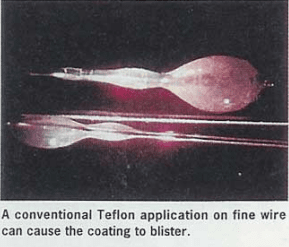Designers of medical probes,sensors, and implants such as heart pacemakers must coat the wiring with plastic to protect patients from electric shock and to
make the devices acceptable to the human body. California Fine Wire of Grovers Beach, Calif., has developed a new process to coat continuous lengths of wire as fine as 0.005 and finer with polytetrafluoroethylene, better known as Du Pont’s Teflon. N.B.L. of Denison, Texas,uses medical wire coated in this manner for its electroarrays, used in brain research.
Medical wiring currently uses parylene coating. This plastic has similar properties to PTFE, but typically coats only short lengths of wire, about 10 feet, due to the space limitations of the vacuum furnace in which the material is deposited on the wire. This limits the use of parylene coated wire in longer production runs.
Some wire manufacturers attempted to use PTFE as a substitute, trading on PTFE’s ability to obtain high dielectric values and its proven inertness in medical implants.They would run continuous lengths of fine wire through an insulating bath of liquefied PTFE and then send it through a continuous furnace to set the coating.However, the process experienced such problems as blistered and holed coatings, which are unacceptable in
medical applications.
California Fine Wire engineers refined the technique to eliminate coating defects in continuous lengths of fine wire as long as 10,000 feet.In addition to medical applications,the company is aiming its PTFE coated wire toward semiconductor manufacturing, where PTFE’s resistance to subzero temperatures is a key attribute. M.V.


